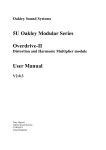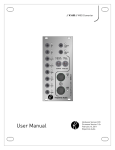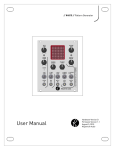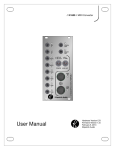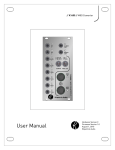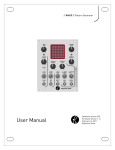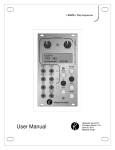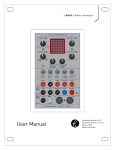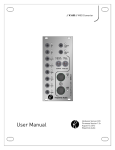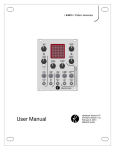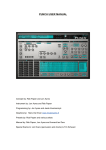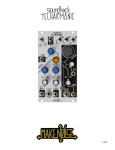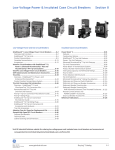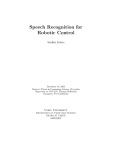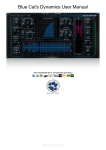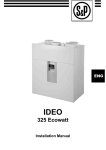Download User`s Manual
Transcript
Kilpatrick Format // Modular Synthesizer // System Manual // i // Kilpatrick Format // Modular Synthesizer // System Manual Contents Introduction.................................................................................................. 1 General Usage.............................................................................................. 2 Basic Synthesizer Patching......................................................................................2 Signals and Voltages.................................................................................................4 Enclosure and Module Installation...........................................................................6 Patch Cables.............................................................................................................7 Modules........................................................................................................ 8 K1 // Mixer Interface.................................................................................................8 K2 // Pitch Oscillator...............................................................................................14 K3 // Digital Effects.................................................................................................16 K4 // Envelope Modulator.......................................................................................19 K5 // Filter Amp.......................................................................................................21 Additional Information................................................................................ 23 // ii // Kilpatrick Format // Modular Synthesizer // System Manual Introduction The Kilpatrick format is a new kind of modular synthesizer system for players that demand something better, different and inspiring. Designed by Andrew Kilpatrick, the Kilpatrick format represents a new generation of modular music making by offering the right combination of look and feel, playability, excellent circuit design, and the perfect blend of old and new concepts that make the system easy and fun to use. The Kilpatrick format system aims to provide all the building blocks for experimental sound production in a way that is incredibly intuitive and enjoyable. Discovering new sounds should be something that happens in every session. After several years of research and experimentation, the Kilpatrick format was chosen. Containing new design ideas and the best of traditional modular synthesizer concepts, the format aims to offer the best user experience possible. We hope that you enjoy using your Kilpatrick format system for many years to come! Kilpatrick Format Features: • 4U (7”) panel height - each panel offers close to 30 in. of panel space • Simple plug and play module installation - rearranging a system or adding new modules is easy • Universal use of banana cables for patching of audio, CV and pulse/gate signals high quality cables are available in a variety of colors and lengths • Color-coded jacks indicate different signal functions and direction • Separate analog and digital grounds used for low noise signal returns - plenty of power available for digital modules • Total cabinet depth of less than 3” permits table top or rack mounting • High quality brushed anodized panels are rugged and feature clean, futuristic graphics • All modules and systems are hand-assembled and built-to-order in our downtown Toronto workshop // 1 // Kilpatrick Format // Modular Synthesizer // System Manual General Usage We want to make sure you get the most from your Kilpatrick system. You’ll find that this manual doesn’t offer specific patch ideas or tips on how to achieve certain sounds. That is left up to you. This document aims to outline the various ins and outs (literally) of each module and what all the controls do. Below we’ll begin with a basic overview of general signal and patching tips to help you get started. If you’re an experienced synthesist then the following section will be a review of basic concepts. Feel free to skip ahead to the Signals and Voltages section. Basic Synthesizer Patching When you first set up your system you’ll need to make some connections before any sound will come out. The modular aspect of the system means that there are lots of tools at your fingertips, powered up and ready to go, but it’s up to you to connect them in some sort of useful way. Many keyboard synthesizers are built with a fixed patch internally, and you can make that patch too if you want to get started with something familiar. A basic synth patch might look like: OUTPUT OSCILLATOR PITCH FILTER TIMBRE VCA MIXER VOLUME CONTOUR LFO MIDI INTERFACE GATE ENVELOPE The modules in the patch work as follows: • MIDI INTERFACE - The MIDI input from the keyboard or another device generates information about which note is being played (pitch voltage) and whether or not a key is being pressed down (gate signal). The setup shown above is monophonic and can play one note at a time. Polyphonic synths use multiple oscillators, filters, etc. to play more than one note at at time, and software determines which notes will play on which hardware. // 2 // Kilpatrick Format // Modular Synthesizer // System Manual • OSCILLATOR - The oscillator generates a waveform, usually a basic waveform like a sawtooth, pulse wave, etc. but sometimes more complex waves like sampled waves. The output is generated all the time, the pitch determined by a voltage from the MIDI interface. In analog synths this voltage is usually decided as something like 1V per octave. That means for every 1V increase in the pitch voltage, the output frequency will increase by 1 octave. (double in frequency) • FILTER - The filter changes the timbre of the sound by applying some kind of frequencydependent transformation on it. The most common filter type is the low-pass filter, which cuts off high frequency sounds. Usually the cutoff frequency is adjustable by a voltage. • LFO - The low-frequency oscillator (LFO) generates a low-frequency signal, usually a triangle or sine wave. The LFO can usually make signals from about 1 cycle per minute, up to maybe 40Hz or so. The LFO is used to modulate some parameter of the sound to create a constantly evolving and changing sound. In the example above the LFO is used to modulate the filter cutoff frequency. • VCA - The voltage-controlled amplifier (VCA) can adjust the volume of a sound from muted to full volume under voltage control. The VCA is the necessary component for making it possible to have sounds that turn on and off when you press and release keys on the keyboard. • ENVELOPE - The envelope generator takes gate (on/off) voltages from the MIDI interface and makes smoothly changing voltages which fade up and down when a key on the keyboard is pressed or released. This is usually used to turn the volume of a sound up and down. Envelopes can also be used as sources of modulation in many places where you might consider an LFO. • MIXER - Most synths contain a mixer section just before the sound comes out to a line output or headphone jack. In a polyphonic setup this is used to mix all the notes together. It also adjusts the master volume, and often contains circuitry for adding reverb, delay or chorus effects to the final sound. This is an overly simplified explanation, but this is the general idea behind most synthesizers. Nearly all digital or analog synthesizers follow a signal flow similar to what was described above. But for experimental sound creation or ultimate flexibility, breaking from this traditional type of patch will open the doors to a world of sonic possibilities. In a modular system you can build a traditional synth patch like the one shown above, or you can patch in a totally different way to create sounds never heard before. // 3 // Kilpatrick Format // Modular Synthesizer // System Manual Signals and Voltages Everything patchable in the Kilpatrick system is voltage-controlled. This concept of representing control parameters with voltages was what made synthesizers practical for musicians back in the 1960s. And now with the rebirth of the modular synthesizer in the present day we can once again experience the flexibility that player-patchable control signals presents. We often speak of CV (control voltage) in which we usually mean a signal that affects a performance parameter, instead of the actual audio signals being generated. In the Kilpatrick format audio and CV signals are interchangeable, and the only difference when thinking about patching is the intended function. CV signals are often held at steady DC voltages, or set up to be slowly changing. Audio signals are usually faster changing signals or percussive impulses. But there is no limit to using CV and audio signals interchangeably. You should always monitor the output with speakers or headphones connected to one of the mixer outputs. Connecting directly to a module output might cause DC voltages to be sent to your headphones or speakers which could damage them. Unlike most audio equipment, the inputs and outputs on the Kilpatrick system are often designed to work all the way down to DC. The headphone and line out jacks are designed to block DC. The Kilpatrick system uses four types of jacks which are color coded to make them easy to distinguish: • CV / Audio Output - GRAY - Control voltages and audio signals come out of gray jacks. These are normally in the range of -5V to +5V. Most outputs are fed through 1K resistors to make them protected from short circuits. The exception is pitch outputs from MIDI to CV converters, which are fed through 100 ohm resistors to provide better tuning accuracy. You should avoid shorting outputs to the chassis or external equipment. • CV / Audio Input - BLACK - Control voltages and audio signals go into black jacks. All black inputs have an input resistance of 20K-50K, with the exception being oscillator pitch inputs which have an input resistance of 100K. • Pulse and Gate Output - RED - Pulse, gate and clock outputs and various other digital type of signals come out of red jacks. These are nominally +5V when on, and 0V when off. They are all fed out through 1K resistors. Pulse and gate output signals can be fed into CV or audio inputs, but the signal will only change from the mid point to the maximum value when the output turns on and off. // 4 // Kilpatrick Format // Modular Synthesizer // System Manual • Pulse and Gate Inputs - WHITE - Pulse, gate and clock inputs go into white jacks. These type of inputs have a resistance of 20K and generally detect any voltage greater than about +1V. Some inputs like oscillator sync inputs might require a fast-changing signal like a ramp or pulse wave to trigger. Any range of input voltage can be input to these jacks making it possible to trigger this type of input from an audio or CV signal. Warning: The only thing to keep in mind when patching is that outputs should not connect to other outputs. Although it may be possible to connect two outputs together to achieve passive mixing, it is not recommended to do this as it can overload the outputs and may cause damage to the module. // 5 // Kilpatrick Format // Modular Synthesizer // System Manual Enclosure and Module Installation Enclosure Setup The smallest size of one module is called a space and occupies a quarter rack width. Larger modules may occupy two or more spaces. An enclosure generally provides four spaces and fits into a 19” equipment rack. Other sizes such as five or six spaces can be custom ordered. Rack ears are used for rack mounting, and stacking brackets are used to attach two enclosures together for table-top use. Enclosures can be ordered as active or passive. Active enclosures take power from an external power supply and generate power for modules internally. Passive enclosures take power from an active enclosure to add additional modules to the same power supply. An active enclosure can power approximately 8-12 modules. When using multiple active enclosures together in the same system it is necessary to connect a ground cable between systems. Banana sockets are provided on each enclosure for this purpose. Connect a short banana cable between the systems and always ensure it is in place before powering up your system. Only connect one of the enclosures to external equipment such as mixers or amplifiers to prevent ground loops. Power Supply The Kilpatrick format system uses a single 15V regulated switching power supply to feed the system. The power input is located on the back of an active enclosure. Only use the included 15V regulated power supply for powering the system. Use of other types of power supplies could damage the system. Module Installation Modules use a plug-and-play system and requires no internal cables. A single captive screw is used to secure the module to the enclosure. Never install or remove modules with power applied! To remove a module: • Power down the system • Loosen the captive screw with the included 2.5mm hex key • Plug a banana cable into two jacks near the top or bottom of the module • Grip the banana plugs and gently pull the unit out at one end • Gently lift the module up out of the enclosure until the internal connectors are completely unplugged // 6 // Kilpatrick Format // Modular Synthesizer // System Manual To install a module: • Power down the system • Set the module into the internal connectors and make sure the module is aligned correctly in the enclosure • Gently press straight down to seat the module in the enclosure • Use the included 2.5mm hex key and turn the captive screw counter-clockwise until a small click is heard • Turn the captive screw clockwise until it is finger tight -- Do not over-tighten the screw or you could damage the module Patch Cables All patch cables used in the Kilpatrick system are of the 4mm banana type. We supply an assortment of colors and lengths with each new system and can offer additional cables upon request. All patch cables supplied are high quality Pomona brand B-type stacking banana cables. We use only Emerson Johnson banana jacks on modules. This combination provides very solid connections, and the stacking function is incredibly useful. Even if plugs are not inserted all the way they can still make excellent contact, making it easy to try out patch ideas just by touching the plug to various points in the system. We offer the following unique patch cable color and length combinations: • 12” GRAY • 12” RED • 12” YELLOW • 18” BLACK • 18” GREEN • 18” ORANGE • 24” BLUE • 24” BROWN • 48” VIOLET // 7 // Kilpatrick Format // Modular Synthesizer // System Manual Modules K1 // Mixer Interface The K1 Mixer Interface module is a combination of a high quality five channel audio mixer and MIDI to CV converter. The mixer is designed for high level signals from other modules and offers both an AUX send for use with effects, and dual stereo outputs on banana and mini jacks, as well as a headphone amplifier with dedicated volume control. Mixer Section The mixer circuit incorporates high quality low-noise inputs on banana jacks. Three mono channels and one stereo channel all contain input level indicators and input level controls. The stereo channel offers an AUX send level control which sends a post-input level blend of the left and right channels to the AUX output. The mono inputs offer level controls, a post-input level AUX send, as well as a pan control. Channel 5 offers a CV input for panning instead of a pan control. The master output contains a stereo level control and a pair of banana jacks suitable for connection to other modules or daisy-chaining several mixers. A pair of mini jacks offer line-level signals that can be output to external audio equipment. Signal level indicators show the levels at the output jacks and sense the levels after the MASTER volume control. A ground jack provides access to the analog ground on the system. A dedicated headphone amplifier provides a stereo output on a mini jack with a dedicated level control. This output can also be used for powered speakers or stereo recorders that work more conveniently with stereo mini cables. MIDI Interface Section The K1 also contains a small but useful MIDI to CV converter. Built on the success of the K1600 MIDI Interface, the MIDI to CV converter on the K1 supports a number of useful MIDI // 8 // Kilpatrick Format // Modular Synthesizer // System Manual to voltage conversions, plus a MIDI THRU jack for daisy-chaining. Outputs can be assigned to note, control change and pitch bend messages. Note playing modes include single (mono) mode, split keyboard mode, two-voice polyphonic mode, which is expandable up to 16 voices with additional modules, Arp Odyssey-style duo-phonic mode, and single (mono) mode with velocity output on the second CV output jack. Outputs are programmed by pressing the SET button to select the output mode to program and then sending a MIDI message to the unit. The MIDI channel, output type and other parameters are stored automatically in the module and restored at power-on. Mixer Interface Connections and Controls Mixer Section Audio signals are input on IN jacks 1-5. Jacks 1 and 2 are a stereo pair and automatically wired to output to L and R respectively. Jacks 3, 4 and 5 are mono inputs. LEVEL 1/2 controls the input level of the stereo input. LEVEL 3, 4 and 5 are used to control the input from the mono channels. Signal indicators on each channel light regardless of the level control setting. This can be used to detect if there is a signal present on an input without having to raise the input level. Each input has an AUX control. AUX 1/2 sends a mix of inputs 1 and 2 to the AUX OUT jack. Each mono channel also has a AUX send which will send to the AUX OUT jack. Note that the AUX controls receive a signal after the input level adjustment. (post-fader) If you turn down an input level control the AUX control signal will also be turned down. Channels 3, 4 and 5 support panning. Channels 3 and 4 have PAN controls which position the signal between the left and right channels on the output. Channel 5 contains a CV input instead of a panel control. Inputting a CV signal of between -5V and +5V will pan the signal from fully left to fully right. The MASTER LEVEL control affects the output signal level on the L and R banana and minijacks. The PHONES LEVEL control affects the output level on the PHONES jack. Both output level controls work independently. MIDI Interface Connections The MIDI IN jack received MIDI signals from a keyboard or other equipment. Signals input to the MIDI IN jack are repeated on the MIDI THRU jack. // 9 // Kilpatrick Format // Modular Synthesizer // System Manual The CV / GATE jacks output a variable voltage (CV) and gate signal (GATE) in response to MIDI input signals. The CV and GATE jacks always operate together in pairs. To set up the MIDI interface, press the SET button to select the correct programming mode by observing the GATE1 and GATE2 indicators. Then send the correct MIDI message to program the outputs. The settings are stored internally and restored when the module is powered on. Note: Channel 16 is reserved and cannot be used for programming. MIDI Setup Modes The outputs are assigned by pressing the SET button until the correct GATE indicator flashing pattern is observed, and then sending a MIDI message to assign the outputs. The K1 automatically learns the MIDI channel and other parameters based on the setup mode. Press the SET button to cycle through the setup modes. If no MIDI message is detected within several seconds no change is made to the current setting. Single (Mono) Mode - GATE 1 indicator flashes (CV1 / GATE1 assign) or GATE 2 indicator flashes (CV2 / GATE2 assign) Single Mode provides monophonic playing on a single CV / GATE output pair. When programming, if you send a note message the MIDI channel will be set and pitch voltages will be output on the CV jack, and gate (note on/off) will be output on the GATE jack. Last-note priority is used and the last 8 notes pressed will be stored and recalled as notes are pressed and released. If you send a CC message when programming, the sent CC number will be output as a variable voltage on the CV jack. The GATE jack will output an on/off signal based on whether the CC level is above or below 50%. If you send a pitch bend message when programming the CV output jack will output a voltage corresponding to the pitch bender position, and the GATE output jack will be on if the bender is raised, or off otherwise. If you bend down instead of up during programming the polarity of the CV signal and GATE response level will be inverted. Split Keyboard Mode - GATE 1 and 2 indicators flash alternating In split keyboard mode both pairs of CV / GATE jacks work together to provide a dual monophonic setup on the same MIDI channel. The note sent to program determines the lowest note of the upper half (CV 2 / GATE 2) of the keyboard. Last-note priority // 10 // Kilpatrick Format // Modular Synthesizer // System Manual is used and the last 8 notes pressed on each half of the keyboard will be stored and recalled as notes are pressed and released. Polyphonic Mode - GATE 1 and 2 indicators flash together Polyphonic mode makes it possible to play more than one note at a time and have voices automatically assigned to different outputs as in a polyphonic synthesizer. Multiple K1 units (theoretically up to 8) can be used together for up to 16 voices of polyphony. Practically speaking 4-6 is probably the maximum number which is reasonable. While programming, the key pressed sets the voice unit number. This tells the K1 which pair of voices it is responsible for playing. Press the white keys from C4 (middle C) to C5 to assign voice unit 1-8. Always start with voice unit 1 and add more units depending on the number of K1s you are using. Voice unit 1 will produce voices 1 and 2. Voice unit 2 will produce voices 3 and 4, and so on. As you hold down more keys more voices will be assigned. Releasing a key will free up a lower numbered slot and the next key pressed will produce an output on this free voice. Arp Mode - GATE 1 indicator flashes and then GATE 2 indicator comes on Arp mode emulates the duo-phonic behavior of the Arp Odyssey synthesizer and offers a nice combination of mono and poly playing with only two oscillators. When a single note is being played both CV and GATE output pairs will play in unison. Due to small analog variations in the CV output and oscillators, a rich chorused sound will be heard when playing a single note at a time. When a second note is pressed the CV 2 / GATE 2 pair will split off and play the second note. If additional notes are played, monophonic last-note priority is applied to the second voice while CV 1 / GATE 1 hold the first note pressed down. Velocity Mode - GATE 1 indicator flashes and then GATE 2 indicator fades up Velocity mode offers monophonic playing with last-note priority on CV 1 / GATE 1 while the velocity of each last note played is output as variable voltage on CV 2. This allows expressive playing on a touch-sensitive keyboard. The velocity voltage can be used in all kinds of ways: adjust the volume, affect the speed of an LFO or filter cutoff frequency, etc. // 11 // Kilpatrick Format // Modular Synthesizer // System Manual Pitch Bend Range When in a note mode the pitch bend range of CV1 or CV2 can be adjusted. Send a MIDI program change on either CV1 or CV2 assigned channels to adjust the bend range from 1 to 12 semitones. Program change 1-12 selects bend range of 1-12 semitones for CV1. Program change 13-24 selects bend range of 1-12 semitones on CV2. Pitch bend range for CV2 is only used in single mode. Direct Control Mode (Channel 16 Only) The Direct Control Mode on channel 16 uses continuous controller messages to control any of the outputs. This includes the ability to set the CV outputs to any voltage, as well as the ability to turn on or off the GATE outputs. Direct Control Mode CC Action CV1 / CV2 DAC Control: • Use the MSB and LSB bytes to set 12 bits of resolution. CV1 DAC: 16 (MSB), 48 (LSB) CV2 DAC: 17 (MSB), 49 (LSB) ºº MSB = top 7 bits (right justified) ºº LSB = lower 5 bits (left justified) • Value 0 = lowest output voltage • Value 4095 = highest output voltage Control of gate outputs: GATE1: 18 • Value 0-63 = off GATE2: 19 • Value 64-127 = on SYSEX Messages System Exclusive (SYSEX) messages are used by Kilpatrick Audio modules for vendorspecific commands that are not part of the MIDI spec. The K1 MIDI interface channel and mode assignments can be sent in a single SYSEX message. This can be used by sequencing software to reset the interface to a known setting when loading a song. SYSEX packet format: 0xf0 0x00 0x01 0x72 0x43 0x02 [11 setting bytes] 0xf7 // 12 // Kilpatrick Format // Modular Synthesizer // System Manual The meaning of the 11 setting bytes are as follows: Byte Number / Meaning Values 0 = unassigned Byte 1 - CV1 Map 1 = note mode 2 = CC mode 3 = pitch bend mode 0 = unassigned Byte 2 - CV2 Map 1 = note mode 2 = CC mode 3 = pitch bend mode Byte 3 - CV1 Channel 0-14 = MIDI channel 1-15 (channel 16 reserved) Byte 4 - CV2 Channel 0-14 = MIDI channel 1-15 (channel 16 reserved) Byte 5 - CV1 Value CC mode: controller number (0-121) pitch bend mode: 1 = normal, 0 = inverted Byte 6 - CV2 Value CC mode: controller number (0-121) pitch bend mode: 1 = normal, 0 = inverted Byte 7 - Voice Mode 0 = single 1 = split 2 = poly 3 = arp 4 = velocity Byte 8 - Voice Split split voice mode split point: note number Byte 9 - Voice Unit polyphonic voice mode unit number: 0-7 = unit 1-8 Byte 10 - Voice Bend CV1 CV1 bend amount: 1-12 = 1-12 semitones Byte 11 - Voice Bend CV2 CV1 bend amount: 1-12 = 1-12 semitones // 13 // Kilpatrick Format // Modular Synthesizer // System Manual K2 // Pitch Oscillator The K2 Pitch Oscillator is a fully analog voltage-controlled oscillator (VCO) with a traditional sawtooth core and waveshapers that provide sine, triangle, ramp and pulse outputs. Two different pulse modes offer either standard PWM pulse shaping or a unique multi-pulse mode that generates different timbres by producing multiple narrow pulses. Both modes can be pulse width modulated. Front panel tuning is accomplished with coarse and fine tuning controls. Additionally a range switch allows a second coarse control to be added to the tuning signal allowing two ranges of tuning, or offering even more tuning range. A special blend mixing section allows mixing of sine, triangle, ramp and pulse outputs. Two controls blend between sine and ramp, and triangle and pulse waveforms. These two signals are fed into a voltage controlled blending circuit which can be control with the BLEND MIX control or input control voltage. Inputs include a calibrated V/octave input, linear and exponential CV inputs with bi-polar input level controls, a PWM input with level control, and a sync input which can be used to hard sync the oscillator with input pulses from another oscillator. Outputs are provided for the blend mix circuit and also separate outs for sine, triangle, ramp and pulse outputs. Oscillator Connections and Controls Oscillator Core and Tuning The oscillator core is an analog sawtooth core. Tuning is affected by the COARSE and FINE tuning controls. If the RANGE switch is in the OFFSET position the RANGE OFFSET control acts as a second COARSE tuning control, allowing the main tuning range to be shifted up or down by a significant amount. The V/OCT input provides a calibrated 1V/octave control over oscillator pitch. The EXP FM IN provides exponential FM control of pitch. The EXP FM DEPTH control affects // 14 // Kilpatrick Format // Modular Synthesizer // System Manual the scaling of the input and can be set to either + or - so that the input signal can be inverted. (increasing voltage causes decreasing pitch) The LIN FM IN and LIN FM DEPTH control works similarly except that the pitch change is linear with input voltage instead of exponential. Inputting a fast-changing waveform like a pulse wave into the SYNC input will reset the oscillator core to the starting position. This can be used to create unusual timbres by driving it from a second oscillator. PWM Section The PWM section generates the PULSE output. The PWM OFFSET control selects the duty cycle of the pulse waveform. PWM IN and PWM DEPTH allow voltage control of the pulse duty cycle. Waveshaper Outputs The signal from the oscillator core is processed by various analog waveshaping sections before being output on the four main output jacks. The nominal output level is 10Vp-p except the pulse output which is intentionally slightly lower in amplitude. The jacks output the following signals: • RAMP OUT - A processed version of the internal ramp signal from the oscillator core comes out of the RAMP OUT jack. • TRIANGLE OUT - The triangle signal is generated from the ramp signal using an analog waveshaper. This signal comes out of the TRIANGLE OUT jack. • SINE OUT - A smoothed version of the triangle signal is produced to be somewhat sine-like. It is not a low-distortion sine wave, but has a soft and interesting character. • PULSE OUT - The PULSE OUT jack outputs the signal from the PWM section described above. Blend Section Each of the waveshaped outputs is fed into the blend section where they can be mixed to generate more complex waveshapes. Two controls choose a blend of sine and ramp waves, and triangle and pulse waves respectively. These two signals are sent into a voltage-controlled blending circuit which can fade between each signal manually by using the BLEND MIX control or by inputting a voltage into the BLEND CV IN jack. The BLEND OUT jack outputs the final blended signal. // 15 // Kilpatrick Format // Modular Synthesizer // System Manual K3 // Digital Effects The K3 Digital Effects module contains two different digital effect units in a single module. The top REVERB / DELAY section produces high quality reverb and delay effects, all processed at 24 bit. The lower ITTI BITTI section produces lo-fi effects such as bit crushing and sample-rate reduction, wavefolding, distortion and signal multiplication. Reverb and delay effects are geared towards audio signals, whereas the ITTI BITTI effects can be used for both audio and low frequency control voltage signals. Reverb / Delay The REVERB / DELAY section provides high quality stereo reverb and delay effects with a dedicated audio DSP. A mono input and level control are used to feed audio into the processor. The output generates a left and right channel which create expansive reverbs and stereo delays. Three controls allow the reverb mix, delay mix and delay time to be controlled. The delay time can also be controlled with a voltage to create pitch shifted and sped up / slowed down effects. Two reverb algorithms and three delay algorithms are selected with the main PROGRAM control. ITTI BITTI The ITTI BITTI section occupies the lower half of the module. It generates low fidelity audio and CV effects using non-oversampled 12 bit analog converters to create a number of interesting types of distortion and digital processing of both control voltages and audio signals. It creates digital multiplication of two signals, sample and hold with sample-rate and bit depth reduction controls, wave folding with adjustable drive and break points, and a digital distortion effect which creates harmonically rich timbres from simple waveforms. The sample rate of the system is internally generated, or can be fed from a pitch oscillator or other source of pulses. // 16 // Kilpatrick Format // Modular Synthesizer // System Manual Digital Effects Connections and Controls Reverb / Delay Audio is fed into the reverb / delay section through the IN jack. The IN LEVEL control affects the input signal, and the CLIP indicator will blink if the digital signal path is overloaded. The REVERB MIX, DELAY MIX and DELAY TIME controls affect the currently selected reverb and delay programs. The DELAY TIME CV IN jack allows the DELAY TIME control to be adjusted with a control voltage. A stereo output is generated on the L and R OUTS jacks. The reverb and delay programs are selected together by using the PROGRAM control. This control is used for selecting programs for both parts of the module. Click the program control until the REV and DEL indicators are flashing and then turn it to select a combination of reverb and delay programs. There are two reverb programs and three delay programs. The third delay program is shown by lighting both DEL 1 and DEL 2 indicators. A pulse input to the PROG A jack will step through the reverb / delay programs. ITTI BITTI The ITTI BITTI section performs 12 bit audio or control voltage processing using one of four algorithms. There are two inputs. The main signal is fed into the SIG IN jack, and the level is controlled by the SIG LEVEL control. The output is sent out of the SIG OUT jack. Each effect has two parameters which can control the effect response in real-time. The PARAM 1 control is manually adjusted. The PARAM 2 control has a manual adjustment, but can also be controlled by a voltage input into the PARAM 2 CV IN jack. The input level is controlled by the PARAM 2 CV LEVEL control. A pulse input to the PROG B jack will cycle through ITTI BITTI programs. Effect Programs: The ITTI BITTI effects and parameters are as follows: • MULT - Multiplies SIG IN by PARAM 2, which can be either positive or negative. The PARAM 1 control adds a DC offset to the signal. The PARAM 2 control or CV IN can be used to amplitude modulate the SIG IN signal for digital ring modulation or VCAlike effects. • S/H - Sample and hold offers sample-rate and bit depth reduction. The PARAM 1 control adjusts the bit depth from 12 bits down to 1 bit. The PARAM 2 control or CV // 17 // Kilpatrick Format // Modular Synthesizer // System Manual IN adjusts the sample-rate from the maximum rate of approx. 29.7kHz down to less than 1kHz. • FOLD - Fold offers digital wavefolding by applying non-linear transformations to the signal at different thresholds. The PARAM 1 control affects the overall wave folding shape, and PARAM 2 control or CV IN affects the drive level, which changes how hard the input signal hits the wave folding effect. • DIST - Dist offers digital distortion by directly manipulating the bits that represent the signal waveform. The PARAM 1 control chooses which distortion shape is used. The PARAM 2 control or CV input affects the drive level, which changes how hard the input signal hits the distortion effect. External Sample Clock Normally the sample clock for the ITTI BITTI is generated internally at approx. 29.7kHz. However external clock pulses can be input into the SAMPLE CLOCK IN jack to drive the internal processing at an arbitrary rate. The minimum sample frequency is 1 pulse every 30 seconds or less, and the maximum frequency is approximately 30kHz. Once a pulse is received the external clock mode will be activated and the indicator next to the SAMPLE CLOCK IN jack will light. If no clock pulse is received for more than 30 seconds, the internal clock will be reactivated automatically. // 18 // Kilpatrick Format // Modular Synthesizer // System Manual K4 // Envelope Modulator The K4 Envelope Modulator combines two envelope generators and two LFOs into a single module. Each section supports a number of different uses in many types of patches. Envelope Generator Section The two identical envelope generators can operate in one of three modes: attack/hold/release, attack/release, and auto-repeat mode. Both a gate input and manual trigger button can be used to start and stop the envelopes, and the up and down times are voltage controllable. The outputs generate both a variable voltage and a pulse which activates during the release phase of the envelope. LFO Section A dual LFO section generates periodic signals of various speed and amplitude. The speed can be controlled by a voltage as well as by the panel control. The output level can be adjusted over a wide range including the ability to internally clip the output to max and min values. Both channels of the LFO section can be synchronized together and the phase of the second channel can be adjusted ahead or behind by up to 180 degrees. This can be used to generate waveforms which have a known phase shift between them. Envelope Modulator Connections and Controls Envelope Generator Section The envelope generators are labeled 1 and 2. Both envelope generator sections are identical and can operate in one of three modes as set by the MODE switch: attack/hold/release, attack/release, and auto-repeat. The signal on the OUT jack normally sits at the minimum level (-5V) and ramps up to the maximum voltage (+5V) when the envelope is triggered. The UP TIME control affects the time taken to ramp up to the maximum level. The DOWN TIME control affects the time taken to ramp back down to the minimum level. The time range // 19 // Kilpatrick Format // Modular Synthesizer // System Manual on both controls is approx. 1 millisecond to 10 seconds. The UP CV IN and DOWN CV IN jacks can adjust the up or down times under voltage control. During the release phase the CYCLE jack will turn on. Both the GATE IN and adjacent trigger button cause the envelope generator to operate. The envelope modes work as follows: • ATTACK/HOLD/RELEASE - A gate signal will cause the output to ramp up while the gate is held down. Once the maximum value is reached the output is held at this level as long as the gate is on. When the gate is released the signal ramps down. The output ramps up and down in response to the gate signal. • ATTACK/RELEASE - A gate signal will cause the output to ramp up and then down, completing an entire cycle regardless of the gate level. This can be used to extend the length of a short pulse or produce percussive envelopes. • AUTO-REPEAT - When this mode is first selected the output will begin to ramp up and down, repeating automatically. This can be used as an LFO with separately adjustable up and down times. If a gate signal is input the auto-repeat mode will change to a momentary behavior. When the gate is subsequently triggered the envelope will ramp up and down a minimum of one time. (like ATTACK/RELEASE mode) If the gate is continuously held the envelope will continue auto-repeating. LFO Section The LFO units are labeled 3 and 4. The LFO section contains two identical LFO units, except for the PHASE control which is only available on channel 4. An LFO is always operating and normally generates triangle waves. The SPEED control adjusts the LFO speed from 1 cycle ever 60 seconds, to about 40Hz. The SPEED CV IN jack allows voltage control of the speed. The GAIN control adjusts the output signal amplitude from about 10% to 100% amplitude. Increasing the GAIN control fully clockwise will cause the output to generate clipped waves that quickly switch between minimum and maximum values. The SYNC switch allows both LFO channels to output the same frequency as controlled by either LFO channel 3 or 4. In this case the PHASE control allows both outputs to generate the same frequency but allows the phase of channel 4 to be adjusted from -180 to +180 degrees relative to channel 3. // 20 // Kilpatrick Format // Modular Synthesizer // System Manual K5 // Filter Amp The K5 Filter Amp is a quad VCA and low-pass filter combination. Four identical channels offer manual or voltage controlled wide-band VCA, and also a low-pass filter section with controllable resonance. Both circuits operate in tandem with the same CV and input signal, but producing two simultaneous outputs. The K5 uses high-quality, low-noise VCA circuitry throughout. The response is designed to smoothly track the input signal for optimum fades for use with an envelope generator or other type of modulation source. The LEVEL control can be used to tweak the response to suit the type of CV control and input signal. The low-pass filter output has a resonance control which adjusts the response from slight peaking around the cutoff frequency, to extreme settings. The filter is not designed to self-oscillate but it does produce percussive pitched bursts when fed with very low frequency pulses. Filter Amp Connections and Controls Four identical sections are marked 1, 2, 3 and 4. The basic connection is to feed an audio or CV signal into the IN jack on a channel and then obtain one or both of the AMP or LPF output signals. The LEVEL control will simultaneously open and close the VCA and also move the cutoff frequency of the low-pass filter up and down. The LPF output can be used as a low-pass gate by allowing the cutoff frequency to go all the way down to below the audio range. The CV IN jack allows control voltages to be input. These are normally in the range if -5V to +5V and the LEVEL control can be used to adjust the offset of the input signal. For some types of effects it might be desirable to input a smaller amplitude signal if the range of control is too wide. For the low-pass filter, the resonance control is used to adjust how much feedback exists within the filter circuit. The minimum setting has slight amount of peaking around the cutoff frequency, for an interesting yet fairly mild effect. The maximum resonance setting creates // 21 // Kilpatrick Format // Modular Synthesizer // System Manual extreme oscillations on the edges of fast changing waveforms such as ramp or pulse type waveforms. The output amplitude on the LPF jack is lower than the AMP output jack to allow more headroom at high resonance settings. // 22 // Kilpatrick Format // Modular Synthesizer // System Manual Additional Information System Warranty Kilpatrick Audio will warrant all parts of the system against manufacturing defects for a period of one year from the date of purchase. If you have a problem with a module, contact us and arrange to return it to us for repair. After one year, we will offer low cost service on modules for as long as possible. If you have trouble at any time please contact us and we will do our best to help you. No warranty is offered for damage caused by the end user or other equipment. Note: This warranty applies to Kilpatrick format products and takes precedence over our general warranty policies in the case of any differences. Hardware Repair Policy Kilpatrick Audio will repair modules free of charge for the first year after purchase provided that the failure was caused by manufacturing defects. After 1 year, or for damage caused by the user, a minimum charge of $25 is applied to cover transport costs. Do not send items for repair before getting in touch with us. We can usually handle repairs within 1 week. Software Update Policy Some modules have embedded software which we test thoroughly before releasing each product. However, all software contains bugs and thus is not covered by the warranty. Software updates are free for all customers no matter when a module or system was purchased. Shipping to/from Kilpatrick Audio is the responsibility of the customer. We charge a flat rate of $25 to handle return shipping and can usually turn around software updates in 1-2 days. Kilpatrick Format Usage The Kilpatrick Format is unique to Kilpatrick Audio, but we want to make information available to other manufacturers and DIY hackers so they can build high quality modules that work with the Kilpatrick system. We are working on a spec which will be available free of charge for both commercial and noncommercial use. This will be released once we get some systems out there and have time to document all the little details! Need More Help or Support? Kilpatrick Audio provides help for customers exclusively by email. If you have any questions or problems we would be happy to help you. Contact us by email at: [email protected] and we will do our best to answer your questions. // 23 // Kilpatrick Format // Modular Synthesizer // System Manual © Copyright 2012 Kilpatrick Audio Andrew Kilpatrick www.kilpatrickaudio.com PDF-version by Guy Drieghe-D. // 24 // Kilpatrick Format // Modular Synthesizer // System Manual // 25 //




























